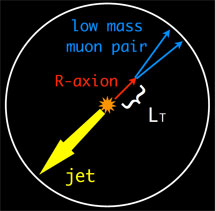
Handy Links
SLAC News Center
SLAC Today
- Subscribe
- Archives: Feb 2006-May 20, 2011
- Archives: May 23, 2011 and later
- Submit Feedback or Story Ideas
- About SLAC Today
SLAC News
Lab News
- Interactions
- Lightsources.org
- ILC NewsLine
- Int'l Science Grid This Week
- Fermilab Today
- Berkeley Lab News
- @brookhaven TODAY
- DOE Pulse
- CERN Courier
- DESY inForm
- US / LHC
SLAC Links
- Emergency
- Safety
- Policy Repository
- Site Entry Form

- Site Maps
- M & O Review
- Computing Status & Calendar
- SLAC Colloquium
- SLACspeak
- SLACspace
- SLAC Logo
- Café Menu
- Flea Market
- Web E-mail
- Marguerite Shuttle
- Discount Commuter Passes
-
Award Reporting Form
- SPIRES
- SciDoc
- Activity Groups
- Library
Stanford
Around the Bay
R-Axion—A Flash from the World Beyond Supersymmetry

One of the main goals of the upcoming experiments at the Large Hadron Collider is the discovery of a new class of subatomic particles, supersymmetric particles. Supersymmetry is a postulated new symmetry of nature that could solve many of the current problems of elementary particle physics. For example, it could explain the nature of the Higgs boson and the identity of the particle that makes up dark matter. Many previous SLAC Today articles from the Theory Group have discussed methods for finding supersymmetry in collider experiments. (For example, see "Catch Me if You Can: Searching for Gluinos at the Tevatron.") What's next?
If supersymmetry is realized in nature, it must be hidden so that the Standard Model looks perfect at the energies explored up to now. First of all, supersymmetric particles must be heavy. This requires that supersymmetry must be spontaneously broken by some mechanism—that is, there must be some natural difference between supersymmetric matter and ordinary matter. In addition, the masses and quantum numbers of supersymmetric particles must satisfy special relations that make the effects of these particles small in flavor-changing and CP-violating processes such as those measured by the BaBar experiment. These requirements constrain the manner in which supersymmetry can be broken.
Many models have been proposed in which supersymmetry is broken in a tidy way without conflicting with the successes of the Standard Model. These successful models share two ingredients. The first is that supersymmetry is broken by new particles with no Standard Model interactions. These particles must be connected to quarks and leptons by some mediating interactions. In some models, gravity provides the connection. In other models, the new particles connect to the Standard Model photons, gluons, and W and Z bosons. Which model is the right one?
To answer this question, physicists need to find ways to probe experimentally how supersymmetry breaking works. For most of the proposed models, the evidence on supersymmetry breaking is indirect. Scientists will look for clues in the details of the mass spectrum of supersymmetric particles, as observed at the LHC. However, there is a particular class of models of supersymmetry breaking that can provide a more direct glimpse of the hidden particles and their interactions. The crucial ingredient is a property of many supersymmetric models called R-symmetry.
R-symmetry is a global symmetry often found in models of spontaneous supersymmetry breaking. R-symmetry forbids the supersymmetric partners of gauge bosons from having mass, and therefore it must be broken in realistic model. Usually, models are built to break R-symmetry by hand. However, it is also possible that R-symmetry could be spontaneously broken. In recent work, University of California Berkeley theorist Hock-Seng Goh and I built models of this type and found some unexpected properties.
The immediate consequence of the spontaneously broken R-symmetry is the existence of a Nambu-Goldstone boson called the R-axion. This particle is similar to the famous Peccei-Quinn axion, which is postulated to resolve the strong-charge-parity problem, but it is much less strongly constrained. The R-axion obtains a mass that is much smaller than the masses of the supersymmetric particles, typically just a few times the mass of the pion. This mass is much larger than that of the Peccei-Quinn axion, but still an R-axion with this mass is free from cosmological and astrophysical constraints. The R-axion couples to gluons and to their supersymmetric partners, the gluinos. The coupling to supersymmetric particles enhances the R-axion couplings at the energy scale of the LHC experiments. Thus, we predict that many R-axions will be produced at the LHC.
The next question is, how can physicists detect the R-axion? The R-axion is very light compared to the energies the will be involved in the LHC, so one might worry whether it will be visible at all. We predict that the R-axion will decay to a pair of muons with a lifetime of about 1 picosecond, similar to the lifetime of the b quark. At the LHC, R-axions are produced at close to the speed of light, and so relativity gives them a long decay path. Therefore, researchers can look for the R-axion by searching for a special class of events. These events have a promptly produced jet with high transverse momentum recoiling against a low mass muon pair produced at a secondary vertex centimeters away from the interaction point. These are very unusual events of a type that theorists have not proposed before.
The R-axion carries a lot of information about the hidden supersymmetry breaking interactions. From the details of its mass and lifetime, we can learn about the energy scale and structure of these new interactions. In this way, we can get hints of the solutions to questions that lie beyond the simple issue of whether there is supersymmetry or not. Let's look out, then, for these tiny flashes of muons in the LHC detectors.
—Masahiro Ibe
SLAC Today, December 18, 2008